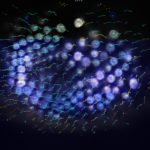Lien vers Pubmed [PMID] – 25482642
Lien DOI – 10.4161/cam.29358
Cell Adh Migr 2014 ; 8(5): 430-9
We present a new technology for super-resolution fluorescence imaging, based on conical diffraction. Conical diffraction is a linear, singular phenomenon, taking place when a laser beam is diffracted through a biaxial crystal. We use conical diffraction in a thin biaxial crystal to generate illumination patterns that are more compact than the classical Gaussian beam, and use them to generate a super-resolution imaging modality. While there already exist several super-resolution modalities, our technology (biaxial super-resolution: BSR) is distinguished by the unique combination of several performance features. Using BSR super-resolution data are achieved using low light illumination significantly less than required for classical confocal imaging, which makes BSR ideal for live-cell, long-term time-lapse super-resolution imaging. Furthermore, no specific sample preparation is required, and any fluorophore can be used. Perhaps most exciting, improved resolution BSR-imaging resolution enhancement can be achieved with any type of objective no matter the magnification, numerical aperture, working distance, or the absence or presence of immersion medium. In this article, we present the first implementation of BSR modality on a commercial confocal microscope. We acquire and analyze validation data, showing high quality super-resolved images of biological objects, and demonstrate the wide applicability of the technology. We report live-cell super-resolution imaging over a long period, and show that the light dose required for super-resolution imaging is far below the threshold likely to generate phototoxicity.



